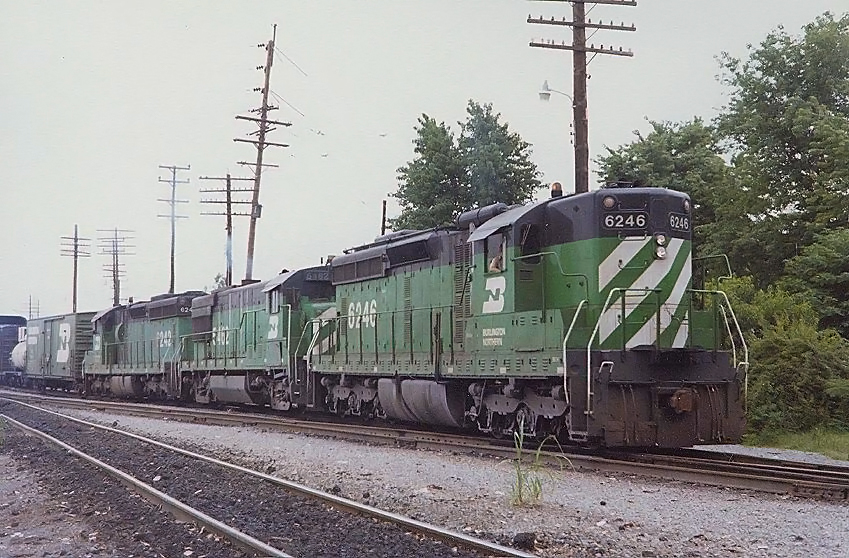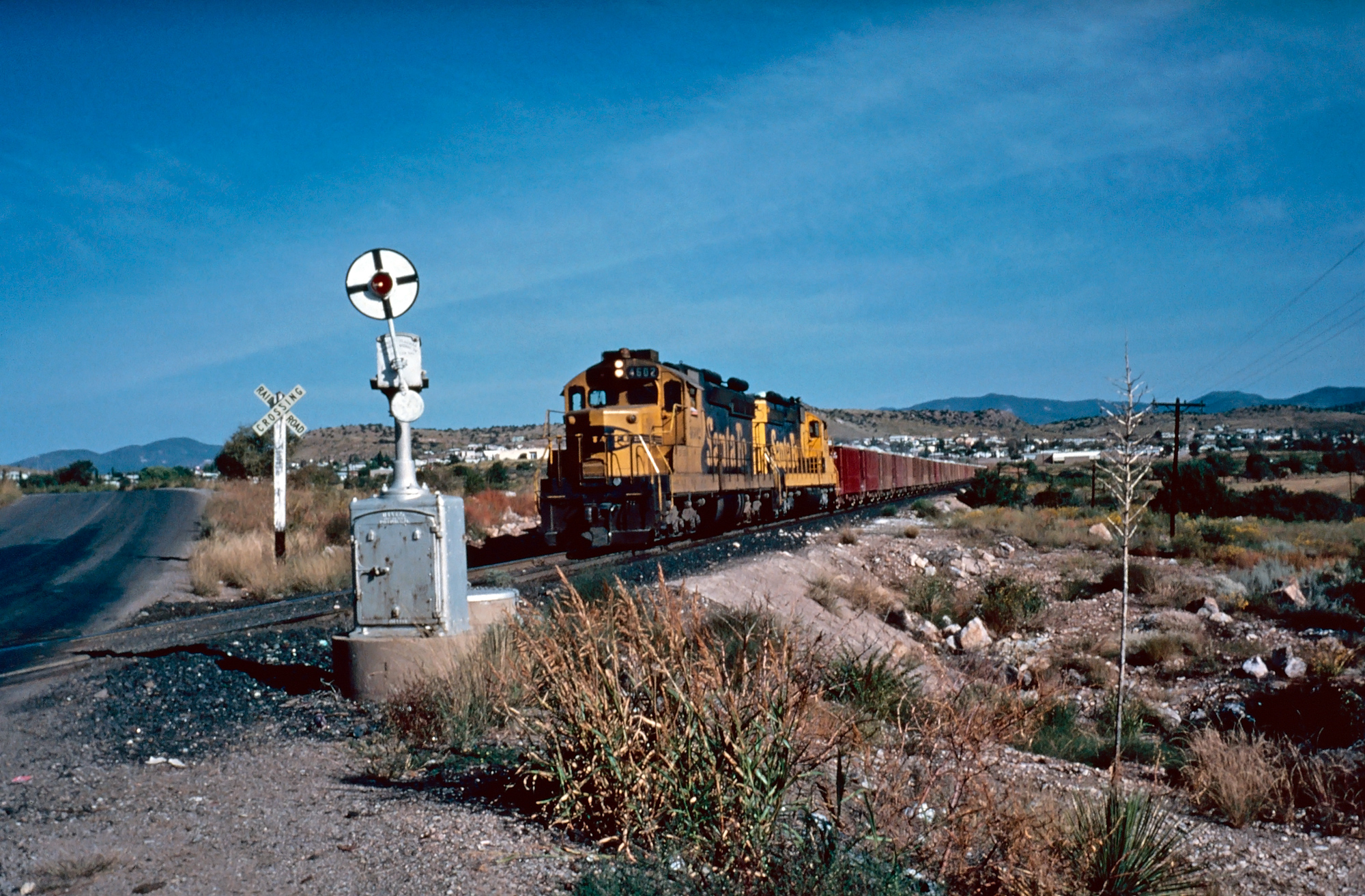EMD's "SD24": Its First Turbocharged Model (1958)
Last revised: August 27, 2024
By: Adam Burns
The SD24 was EMD's turbocharged variant of its early six-axle line which included the SD7, SD9, and SD18. The model featured one of the final versions of the rugged 567 prime mover and could produce an impressive 2,400 horsepower.
The SD24 was one of EMD's first offered with a low, short nose. As Brian Solmon notes in his book, "EMD Locomotives," by the early 1960s there was no longer a need for passenger locomotives while road-switchers were increasingly being utilized in general road service.
As a result, there was a greater need for improved forward visibility. While the SD24 did not feature EMD's later Spartan Cab it did sport an early tapered nose originally introduced on the SD18.
The locomotive saw modest sales although just a handful of railroads would ultimately purchase examples. Interestingly, Union Pacific even ordered cabless B units.
Today, two SD24s are known to be preserved;, Chicago, Burlington & Quincy #504 is completely restored at the Illinois Railway Museum while the National Railroad Museum has CB&Q #510.
Photos
 Burlington Northern SD24 #6246, U28B #5462, and SD24 #6242 were photographed here by Doug Kroll in service at Evansville, Indiana on July 27, 1980.
Burlington Northern SD24 #6246, U28B #5462, and SD24 #6242 were photographed here by Doug Kroll in service at Evansville, Indiana on July 27, 1980.History
During an era when diesel manufacturers - and railroads - were after ever greater horsepower, turbocharging was the answer. Electro-Motive's entry into this arena was the SD24.
While the model featured many common traits with the SD9 and SD18 there were also changes to the carbody. Most notably was the presence of a turbocharger stack. In addition, the SD24 included a lowered area of the roofline where the stack is located.
Finally, on the left side of the carbody, just behind the cab, is a rounded blower housing surrounded by screened radiator shutters. The model was equipped with one of EMD's final versions of its original power plant, the 567D3 which could produce 2,400 horsepower.
It also featured a number of upgrades to ease maintenance and improve in-service performance including a pressurized cooling system and an airtight hood that kept out dust, dirt, and other particles from reaching internal components.
The SD24's primary purpose was the additional axles which offered improved weight distribution and increased tractive effort. Fianlly, its Flexicoil trucks allowed for easier maintenance of its center-axle traction motor. This was a game-changer for six-axle trucks where this center-axle had been traditionally hard to reach.
Turbocharging
The concept of turocharging a diesel engine is straightforward. For any internal combustion engine, its power is the result of an ignition of fuel and air inside a cylinder.
This cylinder is closed at one end with a moving piston located at the other. Any attempt at increasing the mixture of fuel and air will increase the volume of expanded gas when ignited and result in greater power.
However, any increase of injected fuel into the cylinder must result in an equal increase in air to provide proper combustion. Raising the air pressure into the cylinder allows for more air to arrive at the same as the fuel. A turbocharger allows this to occur, driven by a turbine.
 Santa Fe SD26's, led by #4602, are seen here in service near Hurley, New Mexico, circa 1982. Both units are former SD24's, which were upgraded at the San Bernardino shops in 1977. Mike Bledsoe photo. American-Rails.com collection.
Santa Fe SD26's, led by #4602, are seen here in service near Hurley, New Mexico, circa 1982. Both units are former SD24's, which were upgraded at the San Bernardino shops in 1977. Mike Bledsoe photo. American-Rails.com collection.The SD24 was officially EMD's first to feature turbocharging, a concept that dated back to 1955-1956 in tests by Union Pacific to increase the horsepower on its GP9s.
These units became known as Omaha GP20s. At the time, the railroad wanted - and needed - greater horsepower to move increasingly heavier freight trains over the stiff grades of its main line in Wyoming.
EMD was hesitant to turbocharge its own 567 engine but after the successful tests went forward with the concept. The SD24 was the first cataloged with the feature and more than a year later - in November, 1959 - the four-axle, turbocharged GP20 entered production.
Data Sheet and Specifications
| Entered Production | 7/1958 (Demonstrator #5579) |
| Years Produced (SD24) | 7/1958 - 3/1963 |
| Years Produced (SD24B) | 7/1959 - 9/1959 |
| Engine | 567D3 |
| Engine Builder | GM |
| Horsepower | 1200 |
| RPM | 800 |
| Cylinders | 16 |
| Length | 60' 8" |
| Height (Top Of Rail To Top Of Cab) | 15' 0" |
| Width | 10' |
| Weight | 390,000 Lbs |
| Fuel Capacity | 2400 Gallons |
| Air Compressor | Gardner-Denver |
| Air Compressor Model | WBO |
| Air Brake Manufacturer | Westinghouse |
| Air Brake Schedule | 6BL |
| Trucks | C-C |
| Truck Type | Flexicoil |
| Truck Wheelbase | 13' 7" |
| Wheel Size | 40" |
| Traction Motors | D47 (6), GM |
| Primary Generator | D22, GM |
| Auxiliary Generator | Delco (A8102) |
| Alternator | D14 |
| MU (Multiple-Unit) | Yes |
| Dynamic Brakes | Yes |
| Gear Ratio | 62:15 |
| Tractive Effort (Starting) | 97,500 Lbs at 25% |
| Tractive Effort (Continuous) | 72,300 Lbs at 9.3 mph |
| Top Speed | 65 mph |
Production Roster
SD24
Total Built = 179
| Owner | Road Number(s) | Serial Number(s) | Order Number | Completion Date |
|---|---|---|---|---|
| Electro-Motive (Demonstrator) | 5579 (became Union Pacific #448) | 24701 | 5579 | 7/1958 |
| Santa Fe | 900-929 | 25167-25196 | 5597 | 4/1959-7/1959 |
| Chicago, Burlington & Quincy | 500-515 | 25197-25212 | 5598 | 5/1959 |
| Santa Fe | 930-944 | 25327-25341 | 5597 | 6/1959-7/1959 |
| Union Pacific | 400-429 | 25358-25387 | 5602 | 7/1959-9/1959 |
| Southern | 2502-2524 | 25598-25620 | 5606 | 10/1959-12/1959 |
| Southern (New Orleans & North Eastern) | 6950-6951 | 25621-25622 | 5606 | 11/1959 |
| Southern (New Orleans & North Eastern) | 6952-6953 | 25652-25653 | 5606 | 12/1959 |
| Southern (Cincinnati, New Orleans & Texas Pacific) | 6305-6325 | 25654-25674 | 5606 | 12/1959-2/1960 |
| Santa Fe | 945-979 | 25855-25889 | 5617 | 5/1960-7/1960 |
| Electro-Motive (Demonstrators) | 7200-7202 (became Union Pacific #445-447) | 26034-26036 | 5623 | 8/1960 |
| Kennecott Copper Corporation | 904 | 28170 | 5649 | 3/1963 |
SD24B
Total Built = 45
| Owner | Road Number(s) | Serial Number(s) | Order Number | Completion Date |
|---|---|---|---|---|
| Union Pacific | 400B-444B | 25388-25432 | 5602 | 7/1959-9/1959 |
While the SD24 was offered with an optional steam boiler for passenger service, no railroads ordered theirs with such a feature. Additionally, only Kennecott Copper's single unit, #904, did not feature multiple-unit capability (MU).
The railroads which went on to purchase the locomotive included:
- Santa Fe (900–979)
- Burlington (500–515)
- Southern/Cincinnati, New Orleans & Texas Pacific/New Orleans Northeastern (2502–2524, 6305–6325, and 6950–6953)
- Union Pacific who purchased the only B units (400–429 [As] and 400B–448B [Bs}). Additionally, EMD's four demonstrators went to UP.
Sources
- Foster, Gerald. A Field Guide To Trains. New York: Houghton Mifflin, 1996.
- Hayden, Bob. Diesel Locomotives: Cyclopedia, Volume 2 (Model Railroader). Milwaukee: Kalmbach Publishing Company, 1980.
- Marre, Louis A. Diesel Locomotives: The First 50 Years, A Guide To Diesels Built Before 1972. Milwaukee: Kalmbach Publishing Company, 1995.
- Pinkepank, Jerry A. Diesel Spotter's Guide. Milwaukee: Kalmbach Publishing Company, 1967.
- Schafer, Mike. Vintage Diesel Locomotives. Osceola: MBI Publishing, 1998.
- Solomon, Brian. EMD Locomotives. Minneapolis: MBI Publishing Company, 2006.
Recent Articles
-
Gulf & Mississippi Railroad: The First Regional
Nov 23, 24 02:46 PM
The Gulf & Mississippi Railroad was the first regional railroad formed in the U.S. when Illinois Central Gulf spunoff 713 miles in 1985. It was acquired by MidSouth Rail in 1988. -
MidSouth Rail Corporation: An ICG Spinoff
Nov 22, 24 08:32 AM
MidSouth Rail was one of Illinois Central Gulf's many large spinoffs in the 1980s as the company attempted to streamline operations. It was acquired by Kansas City Southern in 1994. -
The Wrecking Derrick: Railroading's Unsung Hero
Nov 20, 24 12:35 PM
The wrecking derrick was once a vital piece of maintenance-of-way equipment, ensuring rail lines were quickly reopened following an accident or derailment.


